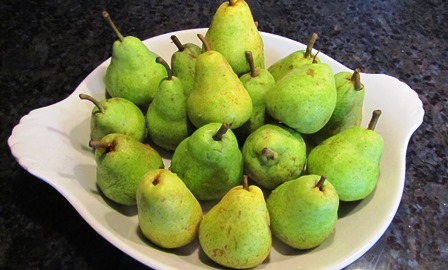Fire Blight Can Ravage a Pear Tree or Take Down an Orchard
I’ve discovered limb tips, fruit, and blossoms blackened by fire blight in my Bartlett pear tree. That means dealing with the disease quickly or losing tree.
While there are dozens of other types of fruit trees on the farmette, there are no other pear trees. Sadly, this one is in bad shape because of a widespread infection by the bacteria Erwinia amylovora.
The blight started last summer and, despite spraying to control it, the disease has overwintered in the bark of the tree to reappear with the emergence of blossoms this year. Disease spread is helped along by the bees.
Fire blight’s vicious cycle and must be broken if the tree is to survive. The life cycle of blight can be seen at a glance at http://nysipm.cornell.edu/factsheets/treefruit/diseases/fb/fb_cycle.gif
Treatment starts with a vigorous pruning of the affected limbs. That means cutting back twelve inches from the site of the blackened area of fire blight. The disease is highly contagious, so the cuttings must not be recycled or composted. Burning them is recommended.
Also, minimizing the amount of tree blight inoculum in the orchard is important as this disease can also spread to other pear trees, apples, quince, raspberries, and fire-thorn bushes. Cornell recommends a regular spraying program using an appropriate bacteriocide to save fruit trees infected with fire blight.
The saddest thing of all for me is that the tree was once beautiful and healthy and (even now) is loaded with fruit. I hate to think of not being able to save this lovely pear tree. Since most pear cultivars are susceptible to fire blight, it might make sense for me to plant a Seckel Pear tree since it is less susceptible to this highly contagious disease that can destroy a single tree or ravage the entire orchard.
Lavender Oil and Aloe Vera to Treat a Minor Burn
Lavender oil can reduce the pain of a minor burn and minimize inflammation. Since lavender oil is also an antiseptic, it serves to reduce the risk of a a secondary infection.
For a simple burn, run the afflicted area beneath cool water and then apply lavender oil. Next, cut a piece of aloe vera plant (if you have one growing in your kitchen or home), and apply the sap to the burn.
Perhaps you don’t own an aloe vera plant but have aloe vera cream. Cream or lotion of aloe vera without fixatives can also be applied to the burn. A dry bandage or Telfa pad to cover and possibly Tylenol or ibuprofen (for pain) is all that is required for a minor burn.
For a deeper burn or one acquired from contact with chemicals, electricity, or radiation, seek immediate medical attention.
 Facebook
Facebook Goodreads
Goodreads LinkedIn
LinkedIn Meera Lester
Meera Lester Twitter
Twitter






